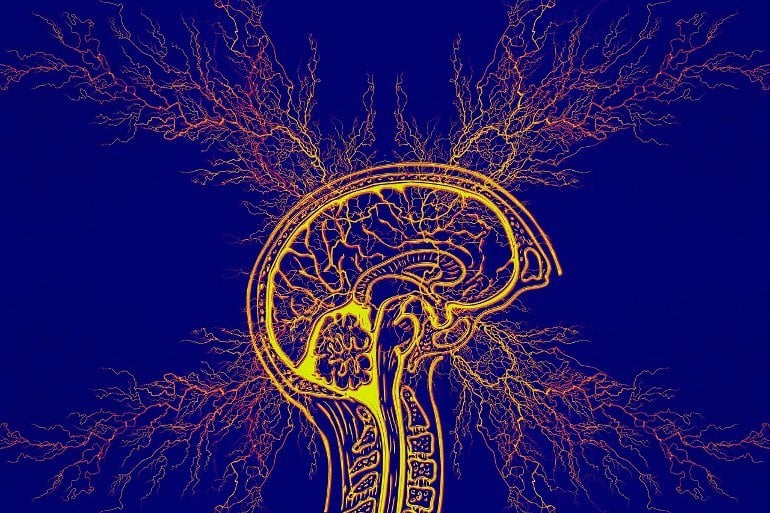Summary: Study identifies a group of proteins in the cerebrospinal fluid that could serve as biomarkers for inflammation in the brain.
Source: University of Tübingen
Alzheimer’s, Parkinson’s and other neurodegenerative diseases are associated with inflammatory processes in the brain. German researchers have succeeded in identifying a group of proteins in cerebrospinal fluid that could provide information about such inflammatory processes.
As so-called biomarkers, the proteins could help researchers to better understand disease processes in the future and to test the effect of potential drugs against brain inflammation.
The research team led by Stephan Käser and Professor Dr. Mathias Jucker at the Hertie Institute for Clinical Brain Research and the University of Tübingen, in collaboration with Professor Dr. Stefan Lichtenthaler from the Munich site of the German Center for Neurodegenerative Diseases, has now published its study in the journal PNAS.
“Inflammatory processes in the brain are common in Alzheimer’s and Parkinson’s disease,” explains Käser, who led the study.
“In these processes, so-called microglial cells play an important role.” Microglia normally protect our brain from harmful pathogens and substances. In the case of a neurodegenerative disease, the cells are chronically active and secrete substances themselves, Käser says.
“We suspect that this reaction initially has a positive effect on the course of the disease, and then turns into a negative impact later on.”
To learn about the dynamic inflammatory reactions in the brain, the Tübingen research team has now searched for possible molecular biomarkers. Biomarkers are substances whose presence or change in concentration in the body indicates a disease process. They can be measured in blood, urine or other body fluids and are an important tool for medical diagnostics or for monitoring the course of a disease.
In the current study, the neuroscientists analyzed cerebrospinal fluid from mice showing characteristic pathologies of Alzheimer’s disease or Parkinson’s disease.
“Using state-of-the art measurement technology, we were able to measure more than 600 proteins simultaneously in just two microliters of cerebrospinal fluid—a tiny drop of fluid,” Käser reports.
“We found that the concentration of 25 proteins was altered in both mouse models compared with healthy animals of the same age.”

“Remarkably, the majority of these proteins originate from or are associated with microglial cells,” the neuroscientist continues.
“Virtually all of them can also be found in human cerebrospinal fluid and are altered in Alzheimer’s patients.”
The changed concentrations of the proteins could reflect different stages of glial cell activity. Thus, they have the potential to serve as biomarkers for various states of brain inflammation, Käser says.
“The ability to measure inflammatory responses in the cerebrospinal fluid would be a major advance,” co-author Jucker explains.
“This would allow us to better understand different disease stages and also to test anti-inflammatory substances in clinical trials.”
This way, the new findings from the laboratory would find practical application in patient care and be a good example of translational brain research.
About this neuroinflammation research news
Author: Press Office
Source: University of Tübingen
Contact: Press Office – University of Tübingen
Image: The image is in the public domain
Original Research: Closed access.
“Signatures of glial activity can be detected in the CSF proteome” by Timo Eninger et al. PNAS
Abstract
Signatures of glial activity can be detected in the CSF proteome
Single-cell transcriptomics has revealed specific glial activation states associated with the pathogenesis of neurodegenerative diseases, such as Alzheimer’s and Parkinson’s disease.
While these findings may eventually lead to new therapeutic opportunities, little is known about how these glial responses are reflected by biomarker changes in bodily fluids. Such knowledge, however, appears crucial for patient stratification, as well as monitoring disease progression and treatment responses in clinical trials.
Here, we took advantage of well-described mouse models of β-amyloidosis and α-synucleinopathy to explore cerebrospinal fluid (CSF) proteome changes related to their respective proteopathic lesions.
Nontargeted liquid chromatography-mass spectrometry revealed that the majority of proteins that undergo age-related changes in CSF of either mouse model were linked to microglia and astrocytes.
Specifically, we identified a panel of more than 20 glial-derived proteins that were increased in CSF of aged β-amyloid precursor protein- and α-synuclein-transgenic mice and largely overlap with previously described disease-associated glial genes identified by single-cell transcriptomic.
Our results also show that enhanced shedding is responsible for the increase of several of the identified glial CSF proteins as exemplified for TREM2. Notably, the vast majority of these proteins can also be quantified in human CSF and reveal changes in Alzheimer’s disease cohorts.
The finding that cellular transcriptome changes translate into corresponding changes of CSF proteins is of clinical relevance, supporting efforts to identify fluid biomarkers that reflect the various functional states of glial responses in cerebral proteopathies, such as Alzheimer’s and Parkinson’s disease.






